I have 2 files.
- myTableViewController.swift
- myTableCell.swift
Can I get the indexPath.row in myTabelCell.swift function?
Here is myTableCell.swift
import UIKit
import Parse
import ActiveLabel
class myTableCell : UITableViewCell {
//Button
@IBOutlet weak var commentBtn: UIButton!
@IBOutlet weak var likeBtn: UIButton!
@IBOutlet weak var moreBtn: UIButton!
override func awakeFromNib() {
super.awakeFromNib()
}
@IBAction func likeBtnTapped(_ sender: AnyObject) {
//declare title of button
let title = sender.title(for: UIControlState())
//I want get indexPath.row in here!
}
Here is myTableViewController.swift
class myTableViewController: UITableViewController {
//Default func
override func viewDidLoad() {
super.viewDidLoad()
//automatic row height
tableView.estimatedRowHeight = 450
tableView.rowHeight = UITableViewAutomaticDimension
}
// cell config
override func tableView(_ tableView: UITableView, cellForRowAt indexPath: IndexPath) -> UITableViewCell {
//define cell
let cell = tableView.dequeueReusableCell(withIdentifier: "myTableCell", for: indexPath) as! myTableCell
}
As you can see... I'm trying to get indexPath.row in myTableCell, liktBtnTapped function.
Could you let me know how can I access or get IndexPath.row?
